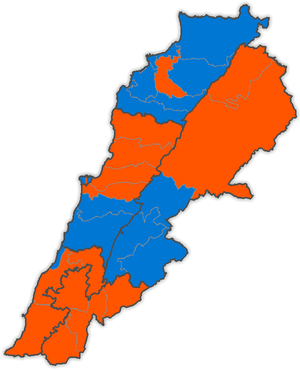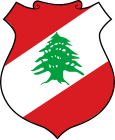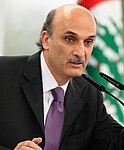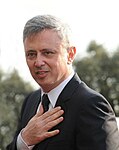2009 Lebanese general election
| ||||||||||||||||||||||||||||||||||||||||||||||||||||||||||||||||||||||||||||||||||||||||||||||||||||||||||||
All 128 seats to the Parliament of Lebanon | ||||||||||||||||||||||||||||||||||||||||||||||||||||||||||||||||||||||||||||||||||||||||||||||||||||||||||||
|---|---|---|---|---|---|---|---|---|---|---|---|---|---|---|---|---|---|---|---|---|---|---|---|---|---|---|---|---|---|---|---|---|---|---|---|---|---|---|---|---|---|---|---|---|---|---|---|---|---|---|---|---|---|---|---|---|---|---|---|---|---|---|---|---|---|---|---|---|---|---|---|---|---|---|---|---|---|---|---|---|---|---|---|---|---|---|---|---|---|---|---|---|---|---|---|---|---|---|---|---|---|---|---|---|---|---|---|---|
| Turnout | 55.2% | |||||||||||||||||||||||||||||||||||||||||||||||||||||||||||||||||||||||||||||||||||||||||||||||||||||||||||
| ||||||||||||||||||||||||||||||||||||||||||||||||||||||||||||||||||||||||||||||||||||||||||||||||||||||||||||
 Areas with a March 14 majority in blue, areas with a March 8 majority in orange | ||||||||||||||||||||||||||||||||||||||||||||||||||||||||||||||||||||||||||||||||||||||||||||||||||||||||||||
| ||||||||||||||||||||||||||||||||||||||||||||||||||||||||||||||||||||||||||||||||||||||||||||||||||||||||||||
 |
|---|
|
|
Parliamentary elections were held in Lebanon on 7 June 2009[1][2] to elect all 128 members of the Parliament of Lebanon.
Background
This section needs expansion. You can help by adding to it. (July 2010) |
Before the election, the voting age was to be lowered from 21 to 18 years, but as this requires a constitutional amendment, it did not happen before the election.[3]
Allocation of seats
Following a compromise reached in the Doha Agreement on May 2008 between the government and opposition, a new electoral law was put in place, as shown in the table below.[4] It was passed on 29 September 2008.[5]
| Total | Maronites | Shi'a | Sunni | Greek Orthodox | Druze | Armenian Orthodox | Greek Catholic | Alawite | Protestant | Minorities | 14 March | 8 March | ||
|---|---|---|---|---|---|---|---|---|---|---|---|---|---|---|
| Beirut 19 |
Beirut 1 | 5 | 1 | - | - | 1 | - | 1 | 1 | - | - | 1 | 5 | 0 |
| Beirut 2 | 4 | - | 1 | 1 | - | - | 2 | - | - | - | - | 2 | 2 | |
| Beirut 3 | 10 | - | 1 | 5 | 1 | 1 | - | - | - | 1 | 1 | 10 | 0 | |
| Bekaa 23 | Baalbek +Hermel |
10 | 1 | 6 | 2 | - | - | - | 1 | - | - | - | 0 | 10 |
| Zahleh | 7 | 1 | 1 | 1 | 1 | - | 1 | 2 | - | - | - | 7 | 0 | |
| Rashaya +West Bekaa |
6 | 1 | 1 | 2 | 1 | 1 | - | - | - | - | - | 6 | 0 | |
| Mount Lebanon 35 | Jbeil | 3 | 2 | 1 | - | - | - | - | - | - | - | - | 0 | 3 |
| Kisrawan | 5 | 5 | - | - | - | - | - | - | - | - | - | 0 | 5 | |
| North Metn | 8 | 4 | - | - | 2 | - | 1 | 1 | - | - | - | 2 | 6 | |
| Baabda | 6 | 3 | 2 | - | - | 1 | - | - | - | - | - | 0 | 6 | |
| Aley | 5 | 2 | - | - | 1 | 2 | - | - | - | - | - | 4 | 1 | |
| Chouf | 8 | 3 | - | 2 | - | 2 | - | 1 | - | - | - | 8 | 0 | |
| North Lebanon 28 | Akkar | 7 | 1 | - | 3 | 2 | - | - | - | 1 | - | - | 7 | 0 |
| Dinniyeh +Minieh |
3 | - | - | 3 | - | - | - | - | - | - | - | 3 | 0 | |
| Bsharreh | 2 | 2 | - | - | - | - | - | - | - | - | - | 2 | 0 | |
| Tripoli | 8 | 1 | - | 5 | 1 | - | - | - | 1 | - | - | 8 | 0 | |
| Zgharta | 3 | 3 | - | - | - | - | - | - | - | - | - | 0 | 3 | |
| Koura | 3 | - | - | - | 3 | - | - | - | - | - | - | 3 | 0 | |
| Batrun | 2 | 2 | - | - | - | - | - | - | - | - | - | 2 | 0 | |
| South Lebanon 23 | Saida | 2 | - | - | 2 | - | - | - | - | - | - | - | 2 | 0 |
| Tyre | 4 | - | 4 | - | - | - | - | - | - | - | - | 0 | 4 | |
| Zahrani | 3 | - | 2 | - | - | - | - | 1 | - | - | - | 0 | 3 | |
| Hasbaya +Marjeyoun |
5 | - | 2 | 1 | 1 | 1 | - | - | - | - | - | 0 | 5 | |
| Nabatiyeh | 3 | - | 3 | - | - | - | - | - | - | - | - | 0 | 3 | |
| Bint Jbeil | 3 | - | 3 | - | - | - | - | - | - | - | - | 0 | 3 | |
| Jezzine | 3 | 2 | - | - | - | - | - | 1 | - | - | - | 0 | 3 | |
| Total 128 | 128 | 34 | 27 | 27 | 14 | 8 | 5 | 8 | 2 | 1 | 2 | 71 | 57 | |
Results

Preliminary results indicated that the turnout had been as high as 55%.[7] The March 14 Alliance garnered 71 seats in the 128-member parliament, while the March 8 Alliance won 57 seats. This result is virtually the same as the result from the election in 2005. However, the March 14 alliance saw this as a moral victory over Hezbollah, who led the March 8 Alliance, and the balance of power was expected to shift in its favor.[8] Many observers expect to see the emergence of a National Unity Government similar to that created following the Doha Agreement in 2008.[9]
| Total | % 14M | 14 March | % 8M | 8 March | ||
|---|---|---|---|---|---|---|
| Beirut 19 |
Beirut 1 | 5 | 52.1% | 5 | 47.9% | 0 |
| Beirut 2 | 4 | 50.5% | 2 | 49.5% | 2 | |
| Beirut 3 | 10 | 69.6% | 10 | 31.4% | 0 | |
| Bekaa 23 | Baalbek +Hermel |
10 | 21.6% | 0 | 78.4% | 10 |
| Zahleh | 7 | 52.7% | 7 | 47.3% | 0 | |
| Rashaya +West Bekaa |
6 | 53.3% | 6 | 46.7% | 0 | |
| Mount Lebanon 35 | Jbeil | 3 | 39.6% | 0 | 60.4% | 3 |
| Kisrawan | 5 | 44.9% | 0 | 55.1% | 5 | |
| North Metn | 8 | 48.4% | 2 | 51.6% | 6 | |
| Baabda | 6 | 43.8% | 0 | 56.2% | 6 | |
| Aley | 5 | 61.2% | 4 | 38.8% | 1 | |
| Chouf | 8 | 75.6% | 8 | 24.4% | 0 | |
| North Lebanon 28 | Akkar | 7 | 63.1% | 7 | 36.9% | 0 |
| Dinniyeh +Minnieh |
3 | 70.9% | 3 | 29.1% | 0 | |
| Bsharreh | 2 | 73.4% | 2 | 26.6% | 0 | |
| Tripoli | 8 | 63.5% | 8 | 36.5% | 0 | |
| Zgharta | 3 | 44.2% | 0 | 55.8% | 3 | |
| Koura | 3 | 51.1% | 3 | 48.9% | 0 | |
| Batrun | 2 | 52.2% | 2 | 47.8% | 0 | |
| South Lebanon 23 | Saida | 2 | 63.9% | 2 | 36.1% | 0 |
| Tyre | 4 | 06.8% | 0 | 93.2% | 4 | |
| Zahrani | 3 | 10.0% | 0 | 90.0% | 3 | |
| Hasbaya +Marjeyoun |
5 | 21.4% | 0 | 78.6% | 5 | |
| Nabatiyeh | 3 | 11.6% | 0 | 88.4% | 3 | |
| Bint Jbeil | 3 | 05.8% | 0 | 94.2% | 3 | |
| Jezzine | 3 | 25.5% | 0 | 74.5% | 3 | |
| Total 128 | 128 | 44.5% | 71 | 55.5% | 57 | |
By party after the designation of Najib Mikati in January 2011
Template:Lebanese parliamentary election, 2009 Source
Formation of government
As is typical of Lebanese politics political wrangling after the elections took 5 months.[11] Only in November was the composition of the new cabinet agreed upon: 15 seats for the March 14 Alliance, 10 for the March 8 Alliance, and 5 nominated by Lebanese President Michel Suleiman, who has cast himself as a neutral party between the two main political blocks.[12]
Aftermath
The government fell in January 2011 after the March 8 alliance's 11 ministers withdrew from the government over PM Hariri's refusal to convene a cabinet meeting to discuss possible indictments to be issued by the Special Tribunal for Lebanon.[13]
The March 8 alliance formed a new government in the ensuing six months.
See also
References
- ^ Lebanon's ruling coalition urges lawmakers to ban presidential election - People's Daily Online
- ^ http://english.people.com.cn/90001/90777/90854/6567795.html
- ^ "Lebanon voting age lowered by MPs". BBC News. 2009-03-19. Retrieved 2010-05-07.
- ^ "Lebanon rivals agree crisis deal". BBC News. 2008-05-21. Retrieved 2010-05-07.
- ^ "Lebanon approves new election law". BBC News. 2008-09-30. Retrieved 2010-05-07.
- ^ Blacksmiths of Lebanon: 2009 Electoral Districts
- ^ Slackman, Michael (7 June 2009). "Pro-Western Bloc Defeats Hezbollah in Lebanon Vote". NYT. Retrieved 7 June 2009.
- ^ Slackman, Michael (2009-06-09). "U.S.-Backed Alliance Wins Election in Lebanon". The New York Times. Retrieved 2010-05-07.
- ^ "March 14 bloc wins Lebanon election". Al Jazeera English.
- ^ "Elections 09 - Lebanon Elections 2009". Archived from the original on 2010-06-25. Retrieved 2010-06-04.
- ^ International Foundation for Electoral Systems (9 November 2009). Lebanon's New Government (PDF) (Report). Archived from the original (PDF) on 16 June 2011.
- ^ Worth, Robert F. (2009-11-10). "Impasse Over, Lebanon Forms Cabinet". The New York Times. Retrieved 2010-05-07.
- ^ http://english.aljazeera.net/news/middleeast/2011/01/20111148327398443.html
External links
- Official Site
- Foreign Money Seeks to Buy Lebanese Votes, Robert Worth, April 22, 2009, The New York Times
- Lebanese Elections 2009 BLOG
- Interactive Result Map
- Obama's Path Passes Through Lebanon by Pol Marillas, Opinion, June 2009; European Union Institute for Security Studies








